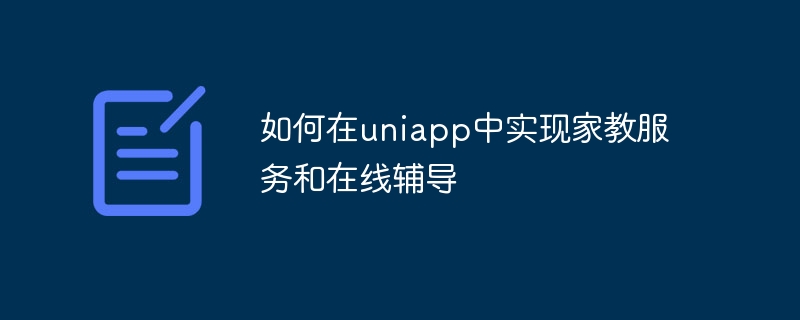Home >Web Front-end >uni-app >How to implement tutoring services and online tutoring in uniapp
How to implement tutoring services and online tutoring in uniapp
- WBOYWBOYWBOYWBOYWBOYWBOYWBOYWBOYWBOYWBOYWBOYWBOYWBOriginal
- 2023-10-27 17:28:451532browse

How to implement tutoring services and online tutoring in uniapp
In recent years, with the development of educational informatization, tutoring services and online tutoring have gradually become a popular choice among students and parents. focus of attention. In this context, using uniapp to develop tutoring services and online tutoring applications has become a good choice. This article will introduce how to implement tutoring services and online tutoring in uniapp, and provide specific code examples.
I. Interface Design
First, we need to design the interface of the application. In uniapp, you can use vue's syntax to implement interface design. The following is an example of interface design for a simple tutoring service and online tutoring application:
<template>
<view>
<image src="/static/logo.png"></image>
<text>欢迎来到家教服务和在线辅导平台!</text>
<button @click="gotoTutor">找家教</button>
<button @click="gotoOnlineTutoring">在线辅导</button>
</view>
</template>
<script>
export default {
methods: {
gotoTutor() {
uni.navigateTo({
url: '/pages/tutor/index'
})
},
gotoOnlineTutoring() {
uni.navigateTo({
url: '/pages/onlineTutoring/index'
})
}
}
}
</script>
<style>
/* 样式表 */
</style> In this example, we pass <image></image> and <text> The </text> tag displays the application's logo and welcome message. Two buttons are implemented through the <button></button> tag. After clicking, they will jump to the "Find a Tutor" and "Online Tutoring" pages respectively.
II. Tutoring service page development
Next, we need to develop the tutoring service page. On this page, users can view tutoring information and make appointments. The following is an example of a simple tutoring service page:
<template>
<view>
<text>家教信息</text>
<view v-for="tutor in tutorList" :key="tutor.id">
<text>姓名:{{ tutor.name }}</text>
<text>专业:{{ tutor.major }}</text>
<text>价格:{{ tutor.price }}</text>
<button @click="reserveTutor(tutor)">预约</button>
</view>
</view>
</template>
<script>
import tutors from '../../data/tutors'
export default {
data() {
return {
tutorList: []
}
},
created() {
this.tutorList = tutors // 获取家教数据
},
methods: {
reserveTutor(tutor) {
// 进行预约逻辑
}
}
}
</script>
<style>
/* 样式表 */
</style>In this example, we cycle through the v-for directive and the <view></view> tag to display tutors Information. Display the tutor's name, major and price through the interpolation syntax of {{ }}. The reservation button is implemented through the <button></button> tag. After clicking, the reserveTutor method will be called to process the reservation logic.
III. Online tutoring page development
Finally, we need to develop an online tutoring page. On this page, users can select tutoring subjects, time, etc., and communicate with online tutors. The following is an example of a simple online tutoring page:
<template>
<view>
<text>选择科目</text>
<select v-model="subject">
<option value="">请选择科目</option>
<option v-for="subject in subjectList" :value="subject">{{ subject }}</option>
</select>
<text>选择时间</text>
<select v-model="time">
<option value="">请选择时间</option>
<option v-for="time in timeList" :value="time">{{ time }}</option>
</select>
<text>问题描述</text>
<textarea v-model="description"></textarea>
<button @click="submit">提交</button>
</view>
</template>
<script>
export default {
data() {
return {
subject: '',
subjectList: ['数学', '英语', '物理', '化学'],
time: '',
timeList: ['周一下午', '周二上午', '周三下午', '周四上午'],
description: ''
}
},
methods: {
submit() {
// 提交在线辅导请求逻辑
}
}
}
</script>
<style>
/* 样式表 */
</style>In this example, we implement a drop-down list for selecting subjects and time through the <select></select> tag. Bind the selected value to the subject and time variables through the v-model directive. The input box for the problem description is implemented through the <textarea></textarea> tag, and the input value is bound to the description variable through the v-model instruction. The submit button is implemented through the <button></button> tag. After clicking, the submit method will be called to process the online tutoring request logic.
Through the above code examples, we can implement tutoring services and online tutoring applications. Of course, the above is just an example, and the specific implementation details need to be adjusted and improved according to specific needs. Hope this article helps you!
The above is the detailed content of How to implement tutoring services and online tutoring in uniapp. For more information, please follow other related articles on the PHP Chinese website!

